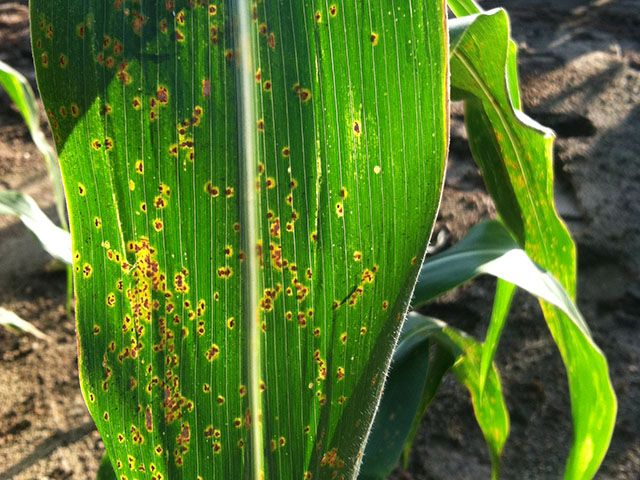International Ag Insurance Solutions issued the following announcement on July 23.
It’s peak season for the University of Illinois Extension plant pathologist, who has been tromping through cornfields in Illinois, hunting for diseases. They have been relatively easy to find, he noted, a sure sign that farmers should be checking their fields.
Southern corn rust is of particular concern this year, as the disease surfaced early in southern states and has been spotted in the Great Plains and Midwest in plenty of time to do economic damage. Kleczewski is also seeing a smattering of tar spot in corn so far this summer.
“If you see something like tar spot or southern corn rust, contact me by Twitter, email or phone call,” he urged Illinois growers. “That way we can confirm it, document it and put it on the map to alert other people.”
And watch for the old summer standbys — gray leaf spot and northern corn leaf blight — which are starting to surface more frequently, especially in well-watered spots, Kleczewski said.
Bacterial diseases such as bacterial leaf streak and Goss’s Wilt are surfacing in Nebraska, added University of Nebraska Extension plant pathologist Tamra Jackson-Ziems. Remember that these diseases, which may favor fields with plant wounds from hail damage, cannot be treated by fungicides.
SOUTHERN CORN RUST
Southern scientists sounded the alarm on the early arrival of southern corn rust in the first week of June. (See more here). By mid-July, it had swept up into eastern Kansas and southeast Nebraska. Now it’s been confirmed in northern Illinois and north-central Missouri, as well. Monitor its spread here.
“The big concern about southern rust is it is an aggressive fungus,” explained Jackson-Ziems. “It can reproduce quickly and it’s airborne.”
Frequent scouting is important, especially when conditions are ideal for its spread — namely, hot with a touch of moisture, Kleczewski said. “It doesn’t need a whole lot of moisture once it’s established in a field,” he warned. “Usually the amount of dew that forms when nighttime temperatures go down is enough for the spores to germinate and infect.”
The spores are easily carried by winds and storm fronts, and many corn hybrids developed for the Midwest and Great Plains are susceptible to the disease.
“Given this combination — it can move fast, conditions are ideal and we don’t have much resistance out there — people need to be looking,” Kleczewski said.
For help scouting for southern corn rust, which can be easily confused with common rust, see this guide.
When sending samples, remember first to contact the plant diagnostic clinic for instructions, as many soil and disease-testing laboratories are facing new procedures for accepting samples because of the pandemic, Jackson-Ziems added.
THE SUMMER STANDBYS
Northern corn leaf blight is showing up frequently in Nebraska fields, which has surprised some people, since the disease is known to prefer cooler, wet conditions, and the state, like much of the Corn Belt, has trended hot and dry recently, Jackson-Ziems said.
“But nighttime temperatures have been pretty cool, which has helped the disease continue to spread,” she explained.
Gray leaf spot, which is perfectly happy in the hotter conditions, is also becoming a common sight on corn leaves, both Kleczewski and Jackson-Ziems added.
Both diseases were lurking the lower canopy of a cornfield Kleczewski was scouting in northwest Illinois, as he talked to DTN. Growers who recently saw rainfalls and storm fronts move through should be especially alert for them, he said.
DTN’s Crop Disease Risk maps shows that a dozen states, stretching from western Nebraska to Ohio and from Kentucky up through central Minnesota, have conditions that put them at high risk for northern corn leaf blight and gray leaf spot right now. In the next week, the high-risk regions for the spread of both diseases will likely retreat northward, according to the maps.
See more on scouting and identifying northern corn leaf blight and gray leaf spot.
TAR SPOT & MORE
The tell-tale black spots of tar spot in corn are surfacing at low levels in several Midwest states this summer. Jackson-Ziems is on the lookout for the disease in Nebraska, as it has steadily expanded its range westward in past years.
Remember that unlike bird or insect droppings, the small black tar spot lesions will not scrape off, said Kleczewski, who has examined many a poop-specked corn leaf in his hunting.
See more on the disease’s identification and management here.
The violent storms and hail that swept across parts of the Corn Belt last week have left many growers with shredded corn leaves and a higher risk of diseases that seek out plant wounds to enter a plant, such as bacterial leaf streak and Goss’s Wilt.
See more on those diseases here and here.
But remember fungicides will not lessen or treat those diseases, and fungal diseases they do treat don’t necessarily worsen after hail damage, both plant pathologists said. See more from Kleczewski on the topic here.
Original source can be found here.

Source: International Ag Insurance Solutions









 Alerts Sign-up
Alerts Sign-up